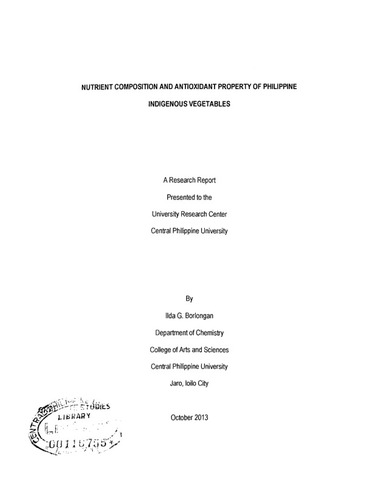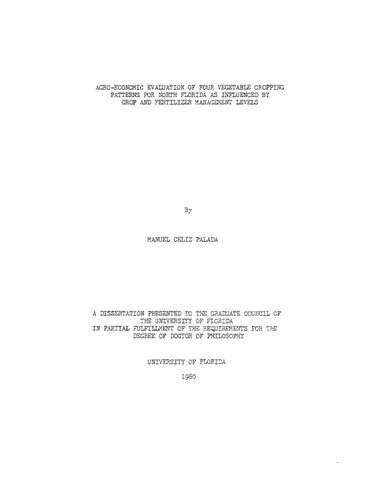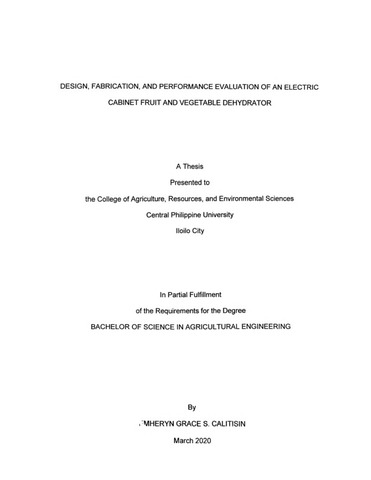Nutrient composition and antioxidant property of Philippine indigenous vegetables
요약
This study determined the nutrient profile and the anti-oxidant property of edible portions of 20 indigenous vegetables commonly consumed in the Philippines. The study concludes that most of the vegetables are important sources of carbohydrates, proteins, fiber, minerals and fats. The vegetables contain minerals (Ca, P and Fe) that can supply our daily micronutrient needs and possess an appreciable amount of anti-oxidant activity that can fight against many of the diseases as nutriceuticals. On the dry weight basis, the protein contents of the vegetables range between 18.4 to 35.4 % with okra having the lowest and jute (saluyot) having the highest. The crude fat contents range from 0.11 to 8.5 % with okra having the lowest value and malunggay having the highest For fiber contents, the values range from 6 to 11.5 % with taro (gabi) having the highest value.
The digestible carbohydrate (NFE) contents of the vegetables are relatively higher in comparison with other nutrients. They range from 38 to 64%. The highest value is from okra and the least in malunggay and gabi. The ash contents range from 5% to 18 % with kolitis having the highest ash content and cowpea (paayap) and pigeon pea (kadyos) have lowest ash contents. The moisture or water contents of the edible portion are high at (68 to 92.5%) leaving the dry matter contents at 7.5 to 32%. Alugbati has the highest moisture content and therefore the lowest dry matter content Cowpea and pigeon pea have the highest dry matter content.
On a percent fresh weight basis, cowpea, pigeon pea and malunggay have the highest protein contents while okra and alugbati have the least. Results also reveal that malunggay has the highest crude fat content Among the leafy vegetable samples, malunggay has the highest fiber content while among the fruit or pod samples, kadyos has the highest fiber. The digestible carbohydrates are highest in kamote tops, malunggay and apat-apat among the leafy vegetables while among vegetable pod samples, highest digestible carbohydrates contents are found in kadyos and cowpea.
Percent ash or mineral contents are highest in malunggay, kolitis with spine, violet lupo and ampalaya tops. As to the specific minerals, calcium (Ca) contents range from 103 to 2977 mg/10Og dry weight with malunggay having the highest and kadyos the least. Phosphorus (P) contents range from 320 to 610 mg/1 OOg dry weight with apat-apat having the highest content. Iron (Fe) contents range from 7.15 to 101 mg/10Og dry weight with jute (saluyot) having the highest value and okra the lowest. The antioxidant properties of the different indigenous vegetables measured as percent free radical scavenging activity and total polyphenolics are relatively high.
The antioxidant activities of all raw leafy vegetables and okra (75.7 to 92%) are higher than those of the blanched (64 to 83.4%) and boiled (59 to 80.1%) counterparts. This indicates that blanching and boiling greatly influence the loss of antioxidant components in leafy vegetables. Blanching decreases the activity from 5 to 15% while boiling decreases the activity by 10 to 25%. For the vegetable pods, no significant differences in anti-oxidant activities are observed in the raw, blanched and boiled samples indicating that blanching and boiling do not affect the anti-oxidant property of these vegetables.
Processing affects content activity and bioavailability of bioactive compounds and therefore health promoting capacity of vegetables depends on their processing history. This aspect should be strictly considered to obtain the optimum nutriceutical benefits from these vegetables. The findings on the nutriceutical importance of these indigenous vegetables to humans should provide a motivation for exploring their horticultural potential.
기술
Abstract only
Full text available
추천 인용
Borlongan, I. G. (2013). Nutrient composition and antioxidant property of Philippine indigenous vegetables (Research report). Jaro, Iloilo City: University Research Center, Central Philippine University.
유형
Technical Report주제
키워드
선반 위치
GSL 540.72 B645
물리적 설명
ii, 35 leaves
Collections
- Research reports [42]
- Research reports [167]
Related items
Showing items related by title, author, creator and subject.
-
Agro-economic evaluation of four vegetable cropping patterns for north Florida as influenced by crop and fertilizer management levels
Palada, Manuel C. (1980)Appropriate crop management technologies for year-round vegetable cropping systems are essential to increase productivity and improve farm income among small-scale vegetable farmers. A 2-year study was conducted to determine ... -
Determination of optimal packaging for distribution of eggplants (Solanum melongena) to selected markets in Iloilo City
Andag, Christian Greg D.; Barrato, Hannah Grace L.; Dagang, Elian Angel I.; Salutin, Tedy Rose G.; Sobremisana, Hannah Joy C.; Velez, Gevic Kay P. (2019-05)This study aimed to determine the optimal packaging for distribution of eggplants (Solanum melongena) to selected markets in Iloilo City. The packaging materials that were studied included woven bamboo basket (kaing), sack ... -
Design, fabrication, and performance evaluation of an electric cabinet fruit and vegetable dehydrator
Calitisin, Emheryn Grace S. (2020)The design of cabinet fruit and vegetable dehydrator aimed to reduce the moisture content of the commodity to lengthen its shelf life while the quality of the product is maintained. It is composed of the following main ...





